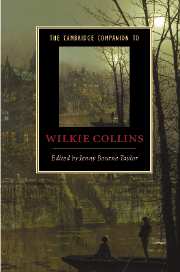Book contents
- Frontmatter
- Introduction
- 1 Collins’s career and the visual arts
- 2 The early writing
- 3 Collins’s shorter fiction
- 4 Collins and the sensation novel
- 5 The Moonstone, detective fiction and forensic science
- 6 The later novels
- 7 The professional writer and the literary marketplace
- 8 The marriage plot and its alternatives
- 9 Collins and Victorian masculinity
- 10 Collins and empire
- 11 Disability and difference
- 12 Collins and the theatre
- 13 The afterlife of Wilkie Collins
- Further reading
- Index
- Series List
1 - Collins’s career and the visual arts
Published online by Cambridge University Press: 28 January 2007
- Frontmatter
- Introduction
- 1 Collins’s career and the visual arts
- 2 The early writing
- 3 Collins’s shorter fiction
- 4 Collins and the sensation novel
- 5 The Moonstone, detective fiction and forensic science
- 6 The later novels
- 7 The professional writer and the literary marketplace
- 8 The marriage plot and its alternatives
- 9 Collins and Victorian masculinity
- 10 Collins and empire
- 11 Disability and difference
- 12 Collins and the theatre
- 13 The afterlife of Wilkie Collins
- Further reading
- Index
- Series List
Summary
When Basil: A Story of Modern Life was published in November 1852, the name of its author, W. Wilkie Collins, was familiar to a handful of readers and reviewers of his only two other works: a biography of his father, the late distinguished painter and Fellow of the Royal Academy, William Collins (1848); and a historical romance, Antonina (1850), which showed, among other signs of promise, that the RA's son had inherited 'a painter's eye for description'. Understandably, then, when reviewers were faced with the unenviable job of reviewing Basil alongside William Makepeace Thackeray's great historical novel, The History of Henry Esmond (published in the same month), many of them seized on what they knew about Collins's family background to draw an analogy between fiction and the fine arts. As Bentley’s Miscellany put it at the end of 1852:
There is the same difference between them as between a picture by Hogarth and a picture by Fuseli. We had well nigh named in the place of [Collins] one of the great painters, whose names are borne by the author of Basil [Collins was named after his godfather, the renowned genre painter, Sir David Wilkie]. But in truth the writer of that work ought to have been called Mr. Salvator Fuseli. There is nothing either of Wilkie or Collins about it.
(CH, p/ 45)- Type
- Chapter
- Information
- The Cambridge Companion to Wilkie Collins , pp. 7 - 22Publisher: Cambridge University PressPrint publication year: 2006
- 4
- Cited by



